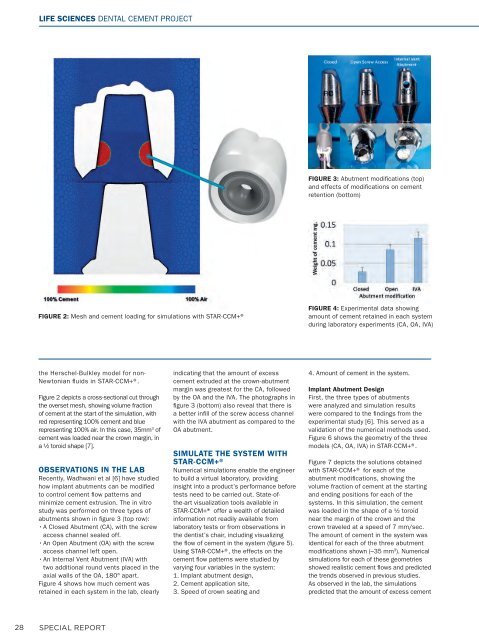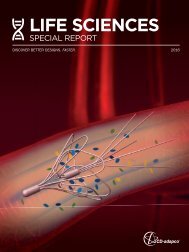Life science special report 161215 IY opt
You also want an ePaper? Increase the reach of your titles
YUMPU automatically turns print PDFs into web optimized ePapers that Google loves.
LIFE SCIENCES DENTAL CEMENT PROJECT<br />
FIGURE 3: Abutment modifi cations (top)<br />
and effects of modifi cations on cement<br />
retention (bottom)<br />
FIGURE 2: Mesh and cement loading for simulations with STAR-CCM+®<br />
FIGURE 4: Experimental data showing<br />
amount of cement retained in each system<br />
during laboratory experiments (CA, OA, IVA)<br />
the Herschel-Bulkley model for non-<br />
Newtonian fl uids in STAR-CCM+®.<br />
Figure 2 depicts a cross-sectional cut through<br />
the overset mesh, showing volume fraction<br />
of cement at the start of the simulation, with<br />
red representing 100% cement and blue<br />
representing 100% air. In this case, 35mm 3 of<br />
cement was loaded near the crown margin, in<br />
a ½ toroid shape [7].<br />
OBSERVATIONS IN THE LAB<br />
Recently, Wadhwani et al [6] have studied<br />
how implant abutments can be modifi ed<br />
to control cement fl ow patterns and<br />
minimize cement extrusion. The in vitro<br />
study was performed on three types of<br />
abutments shown in fi gure 3 (top row):<br />
• A Closed Abutment (CA), with the screw<br />
access channel sealed off.<br />
• An Open Abutment (OA) with the screw<br />
access channel left open.<br />
• An Internal Vent Abutment (IVA) with<br />
two additional round vents placed in the<br />
axial walls of the OA, 180º apart.<br />
Figure 4 shows how much cement was<br />
retained in each system in the lab, clearly<br />
indicating that the amount of excess<br />
cement extruded at the crown-abutment<br />
margin was greatest for the CA, followed<br />
by the OA and the IVA. The photographs in<br />
fi gure 3 (bottom) also reveal that there is<br />
a better infi ll of the screw access channel<br />
with the IVA abutment as compared to the<br />
OA abutment.<br />
SIMULATE THE SYSTEM WITH<br />
STAR-CCM+®<br />
Numerical simulations enable the engineer<br />
to build a virtual laboratory, providing<br />
insight into a product’s performance before<br />
tests need to be carried out. State-ofthe-art<br />
visualization tools available in<br />
STAR-CCM+® offer a wealth of detailed<br />
information not readily available from<br />
laboratory tests or from observations in<br />
the dentist’s chair, including visualizing<br />
the fl ow of cement in the system (fi gure 5).<br />
Using STAR-CCM+®, the effects on the<br />
cement fl ow patterns were studied by<br />
varying four variables in the system:<br />
1. Implant abutment design,<br />
2. Cement application site,<br />
3. Speed of crown seating and<br />
4. Amount of cement in the system.<br />
Implant Abutment Design<br />
First, the three types of abutments<br />
were analyzed and simulation results<br />
were compared to the fi ndings from the<br />
experimental study [6]. This served as a<br />
validation of the numerical methods used.<br />
Figure 6 shows the geometry of the three<br />
models (CA, OA, IVA) in STAR-CCM+®.<br />
Figure 7 depicts the solutions obtained<br />
with STAR-CCM+® for each of the<br />
abutment modifi cations, showing the<br />
volume fraction of cement at the starting<br />
and ending positions for each of the<br />
systems. In this simulation, the cement<br />
was loaded in the shape of a ½ toroid<br />
near the margin of the crown and the<br />
crown traveled at a speed of 7 mm/sec.<br />
The amount of cement in the system was<br />
identical for each of the three abutment<br />
modifi cations shown (~35 mm 3 ). Numerical<br />
simulations for each of these geometries<br />
showed realistic cement flows and predicted<br />
the trends observed in previous studies.<br />
As observed in the lab, the simulations<br />
predicted that the amount of excess cement<br />
28 SPECIAL REPORT



